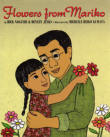Book Description from the Front Cover FlapWORLD WAR II IS OVER. After almost three years, Mariko and her family are finally allowed to leave Camp. But the transition back into society isn't easy. Mariko's father longs to restart his gardening business, but his truck has been stolen. The family moves to a trailer park, where Mariko sees her parents are worried and her father's spirits are low.One day, Mariko's father gives her two packs of seeds. The seeds are for the same kinds of flowers her father grew in his garden in Camp. Mariko plants the seeds and tends the tiny shoots faithfully, softly singing Haru-ga kita. Spring is coming. Soon Mariko's hard work pays off, bringing a surprising and unforgettable gift to her family. Based on the injustice endured by Japanese Americans during and after World War II, Flowers from Mariko shows us all the power of hope, love, and a young girl's determination to help her family rebuild their lives. Background on Rick Noguchi & Deneen Jenks and Michelle Reiko KumataRick Noguchi & Deneen Jenks are a husband and wife team living in Culver City, California. Noguchi is the program manager at the UCLA Extension Writers' Program and was formerly an administrator at the Japanese American National Museum in Los Angeles. Both Noguchi and Jenks hold a Master of Fine Arts degree in creative writing from Arizona State University. This is their first children's book.Michelle Reiko Kumata is a contributing artist to Lee & Low's America: A Book of Opposites/Un libra de contraries. She is a staff graphic artist at the Seattle Times and an exhibit coordinator at the Wing Luke Asian Museum in Seattle. A graduate of the School of Visual Arts in New York City, Kumata lives in Seattle, Washington. This is her first picture book. |
|
|||
|
About | Contact | New | Specials | Browsing | Ordering | Conference | Links | Help Copyright © 2008 by AACP, Inc. Most recent revision July 24, 2008 |
||||


